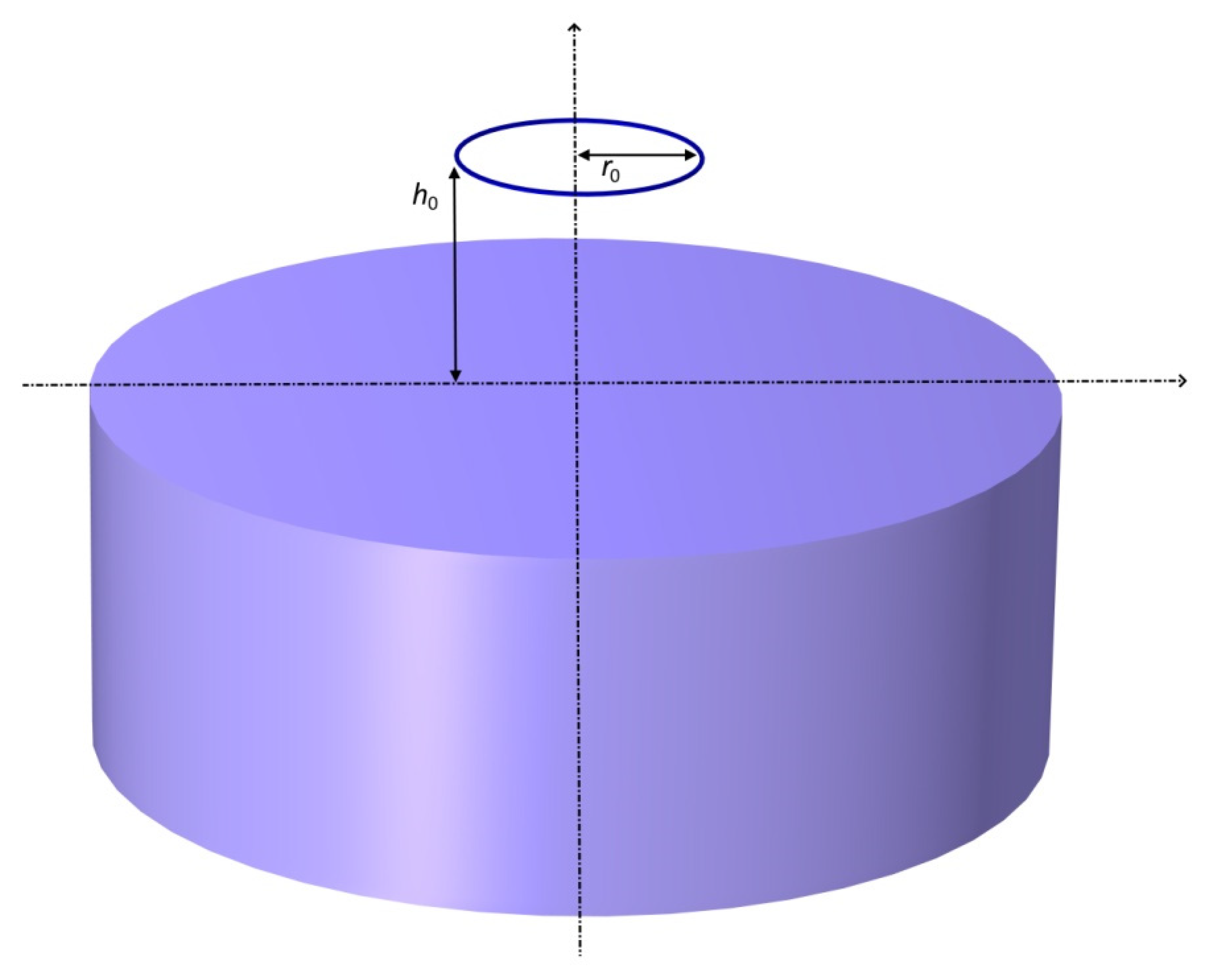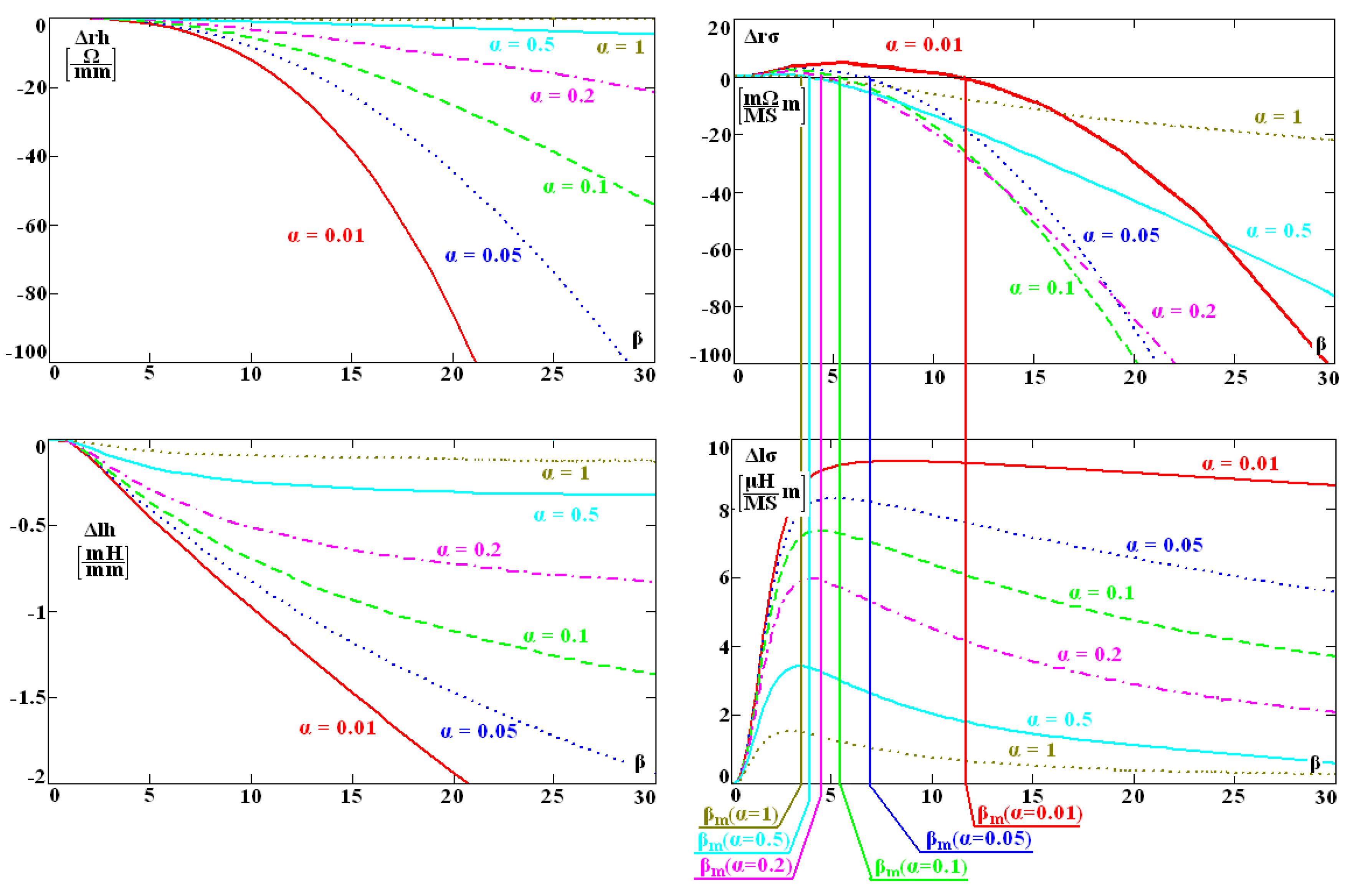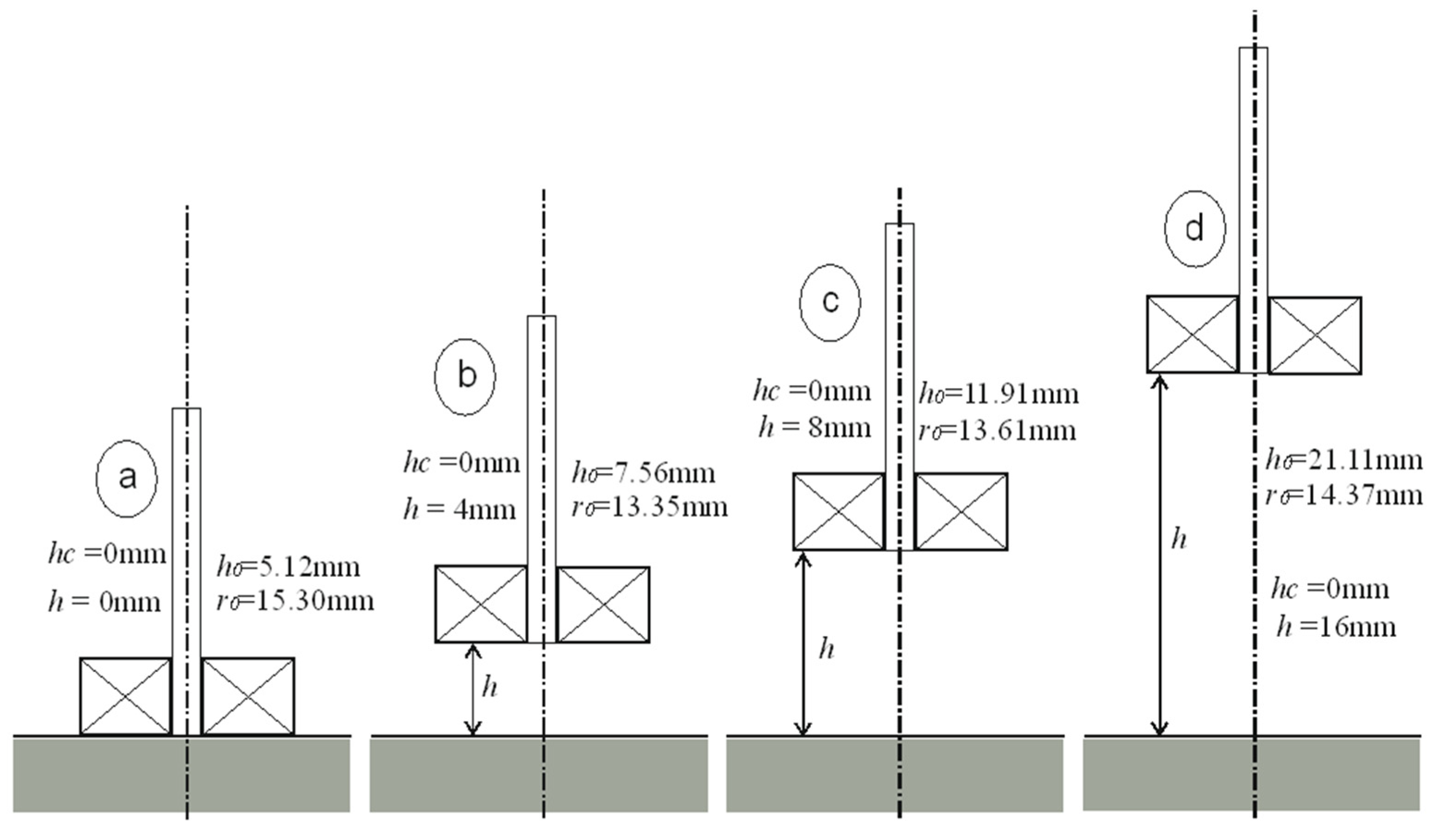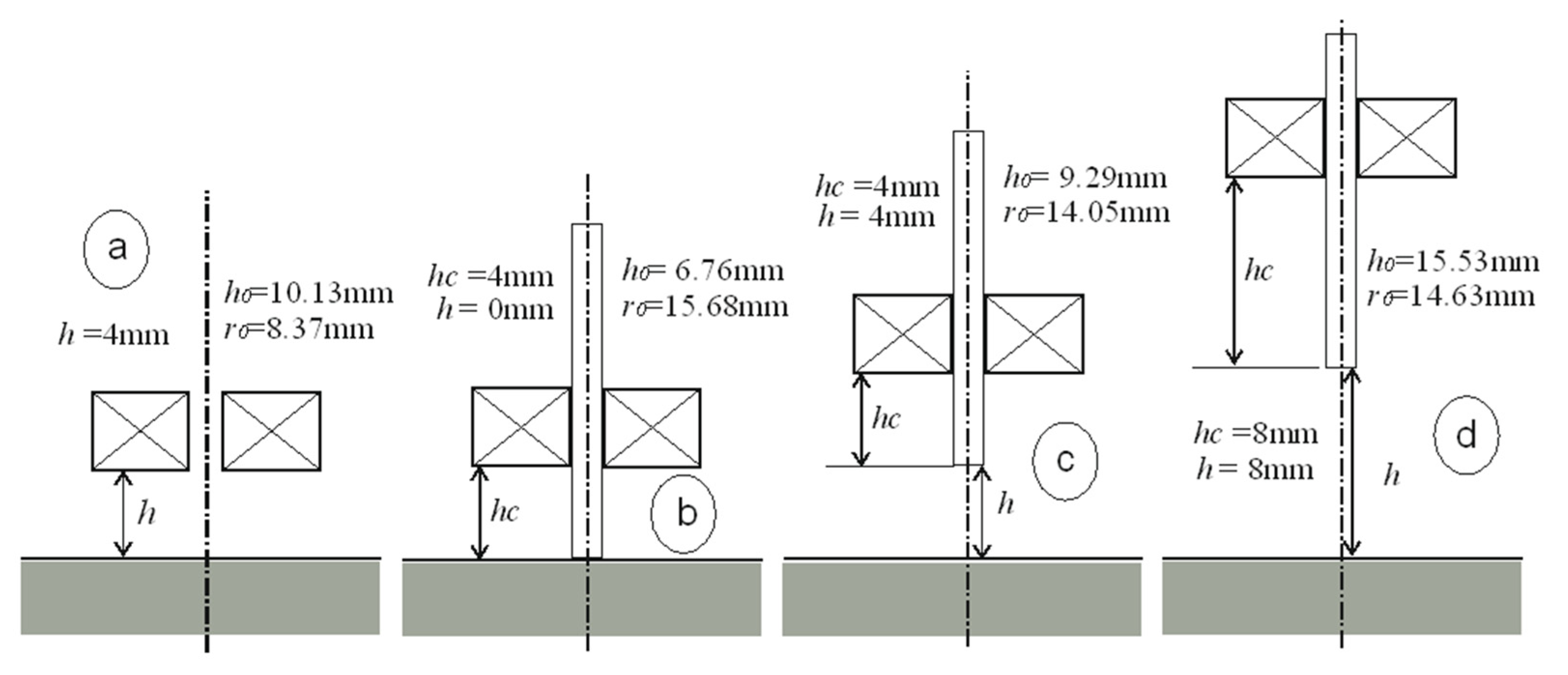Evaluation of the Properties of Eddy Current Sensors Based on Their Equivalent Parameters
Abstract
:1. Introduction
- −
- the sensitivity of the resistance component to lift-off,
- −
- the sensitivity of the inductance component to lift-off,
- −
- the sensitivity of the resistance component to the electrical conductivity of the material under test,
- −
- the sensitivity of the inductance component to the electrical conductivity of the material under test,
- −
- the sensitivity of the resistance component to the magnetic permeability of the material under test,
- −
- the sensitivity of the inductance component to the magnetic permeability of the material under test.
2. Materials and Methods
- −
- the change in the coil resistance resulting from changing the distance of its location from the tested surface (16),
- −
- the change in the coil resistance caused by changing the conductivity of the tested element (17),
- −
- the change in the coil inductance resulting from changing the distance of its location from the tested surface (18),
- −
- the change in the coil inductance caused by changing the conductivity of the tested element (19).
- (1)
- In the first step, the components of impedance Z0 of the sensor positioned away from the conductive material should be measured. During the measurement, it is best to use the same frequency value as in the planned tests.
- (2)
- The second measurement is made for the same sensor after bringing it close to a conductive material of known conductivity σ and known magnetic permeability µr. The impedance Z should be measured at the same frequency as in step 1.
- (3)
- On the basis of the measured impedance values, the changes in resistance ΔR = R − R0 and the changes in inductance ΔL = L0 − L caused by bringing the sensor close to the conductor are determined. In the case of the computer simulation of the tests or at the stage of designing the sensor, the changes in impedance components may be calculated with, for example, the finite element method or analytical expressions.
- (4)
- After obtaining the changes in the impedance components of the sensor, with the employment of the mathematical model of the filamentary coil, substitute parameters r0, h0 are calculated. At this stage, it is also possible to determine coefficients of the sensitivity of the analysed parameter to the change in the resistance and the change in the filamentary coil’s reactance.
3. Results
| Average Value | |||||||||||
|---|---|---|---|---|---|---|---|---|---|---|---|
| h [mm] | hc [mm] | f [kHz] | σ [MS/m] | ΔR [Ω] | ΔX [Ω] | ΔL [mH] | r0 [mm] | h0 [mm] | r0 [mm] | h0 [mm] | Figure Number |
| 0 | - | 10 | 58.42 | 5.81 | 59.88 | 0.95 | 8.30 | 6.13 | 8.30 | 6.13 | Figure 5a and Figure 8a |
| - | 100 | 58.42 | 20.07 | 643.6 | 1.02 | 8.29 | 6.12 | ||||
| - | 10 | 10.47 | 11.44 | 51.25 | 0.82 | 8.31 | 6.14 | ||||
| - | 100 | 10.47 | 44.87 | 615.3 | 0.98 | 8.30 | 6.12 | ||||
| 4 | - | 10 | 58.42 | 1.64 | 21.92 | 0.35 | 8.37 | 10.12 | 8.37 | 10.13 | Figure 5b and Figure 7a |
| - | 100 | 58.42 | 5.55 | 231.5 | 0.37 | 8.36 | 10.12 | ||||
| - | 10 | 10.47 | 3.36 | 19.51 | 0.32 | 8.37 | 10.14 | ||||
| - | 100 | 10.47 | 12.56 | 223.7 | 0.36 | 8.37 | 10.12 | ||||
| 8 | - | 10 | 58.42 | 0.58 | 9.76 | 0.16 | 8.42 | 14.24 | 8.42 | 14.24 | Figure 5c |
| - | 100 | 58.42 | 1.94 | 101.9 | 0.16 | 8.42 | 14.23 | ||||
| - | 10 | 10.47 | 1.23 | 8.92 | 0.14 | 8.43 | 14.25 | ||||
| - | 100 | 10.47 | 4.44 | 99.2 | 0.16 | 8.42 | 14.23 | ||||
| 16 | - | 10 | 58.42 | 0.12 | 2.91 | 0.05 | 8.50 | 22.45 | 8.50 | 22.45 | Figure 5d |
| - | 100 | 58.42 | 0.40 | 30.03 | 0.05 | 8.50 | 22.45 | ||||
| - | 10 | 10.47 | 0.27 | 2.74 | 0.04 | 8.50 | 22.46 | ||||
| - | 100 | 10.47 | 0.93 | 29.47 | 0.05 | 8.50 | 22.45 | ||||
| Average Value | |||||||||||
|---|---|---|---|---|---|---|---|---|---|---|---|
| h [mm] | hc [mm] | f [kHz] | σ [MS/m] | ΔR [Ω] | ΔX [Ω] | ΔL [mH] | r0 [mm] | h0 [mm] | r0 [mm] | h0 [mm] | Figure Number |
| 0 | 0 | 10 | 58.42 | 25.74 | 362.6 | 5.77 | 15.3 | 5.08 | 15.30 | 5.12 | Figure 6a and Figure 8b |
| 100 | 58.42 | 84.69 | 3812 | 6.07 | 15.5 | 5.27 | |||||
| 10 | 10.47 | 55.04 | 325.1 | 5.18 | 15.0 | 4.99 | |||||
| 100 | 10.47 | 195.3 | 3695 | 5.88 | 15.4 | 5.14 | |||||
| 0 | 4 | 10 | 58.42 | 17.45 | 273 | 4.34 | 15.6 | 6.71 | 15.68 | 6.76 | Figure 7b and Figure 8c |
| 100 | 58.42 | 57.15 | 2854 | 4.55 | 15.8 | 6.91 | |||||
| 10 | 10.47 | 37.68 | 247.6 | 3.94 | 15.6 | 6.64 | |||||
| 100 | 10.47 | 123.2 | 2775 | 4.42 | 15.7 | 6.78 | |||||
| 0 | 8 | 10 | 58.42 | 11.57 | 196 | 3.12 | 15.6 | 8.5 | 15.61 | 8.46 | Figure 8d |
| 100 | 58.42 | 37.8 | 2043 | 3.25 | 15.8 | 8.71 | |||||
| 10 | 10.47 | 25.16 | 179.3 | 2.86 | 15.6 | 8.23 | |||||
| 100 | 10.47 | 87.56 | 1991 | 3.17 | 15.5 | 8.39 | |||||
| 4 | 0 | 10 | 58.42 | 10.58 | 155.9 | 2.48 | 13.3 | 7.55 | 13.35 | 7.56 | Figure 6b |
| 100 | 58.42 | 35.46 | 1638 | 2.61 | 13.4 | 7.56 | |||||
| 10 | 10.47 | 22.1 | 140.5 | 2.24 | 13.4 | 7.56 | |||||
| 100 | 10.47 | 80.76 | 1588 | 2.53 | 13.4 | 7.56 | |||||
| 4 | 4 | 10 | 58.42 | 7.79 | 127.9 | 2.04 | 14.0 | 9.28 | 14.05 | 9.29 | Figure 7c |
| 100 | 58.42 | 25.97 | 1336 | 2.13 | 14.0 | 9.28 | |||||
| 10 | 10.47 | 16.47 | 116.5 | 1.86 | 14.1 | 9.31 | |||||
| 100 | 10.47 | 59.36 | 1299 | 2.07 | 14.0 | 9.28 | |||||
| 8 | 0 | 10 | 58.42 | 4.11 | 73.79 | 1.17 | 13.6 | 11.89 | 13.61 | 11.91 | Figure 6c |
| 100 | 58.42 | 13.68 | 768.1 | 1.22 | 13.6 | 11.88 | |||||
| 10 | 10.47 | 8.74 | 67.84 | 1.08 | 13.6 | 11.98 | |||||
| 100 | 10.47 | 31.30 | 749.1 | 1.19 | 13.6 | 11.87 | |||||
| 8 | 8 | 10 | 58.42 | 2.46 | 52.15 | 0.83 | 14.6 | 15.55 | 14.63 | 15.53 | Figure 7d |
| 100 | 58.42 | 8.13 | 539.4 | 0.86 | 14.6 | 15.51 | |||||
| 10 | 10.47 | 5.33 | 48.61 | 0.77 | 14.7 | 15.54 | |||||
| 100 | 10.47 | 18.7 | 528.1 | 0.84 | 14.6 | 15.53 | |||||
| 16 | 0 | 10 | 58.42 | 0.94 | 23.65 | 0.38 | 14.4 | 21.11 | 14.37 | 21.11 | Figure 6d |
| 100 | 58.42 | 3.09 | 243.3 | 0.39 | 14.4 | 21.08 | |||||
| 10 | 10.47 | 2.07 | 22.3 | 0.36 | 14.4 | 21.15 | |||||
| 100 | 10.47 | 7.15 | 238.9 | 0.38 | 14.4 | 21.10 | |||||
4. Discussion
- (1)
- The lower the value of h0, the greater the sensitivity of the sensor.
- (2)
- The higher the value of parameter r0, the greater the changes in the impedance components caused by the change in the measured quantities.
- (3)
- The employment of the core brings “the coil magnetically closer to the tested material”.
- (4)
- The higher the value of parameter r0, the larger the area of the tested element where eddy currents that change the components of the coil impedance are induced.
- (5)
- The higher the value of hc, the lower the sensitivity of the sensor.
- (6)
- The number of turns of the coil does not affect the value of equivalent parameters.
5. Conclusions
Author Contributions
Funding
Institutional Review Board Statement
Informed Consent Statement
Data Availability Statement
Conflicts of Interest
References
- Tytko, G. An eddy current model of pot-cored coil for testing multilayer conductors with a hole. Bull. Pol. Ac. Tech. 2020, 68, 1311–1317. [Google Scholar]
- Faria, A.; Marques, L.; Ferreira, C.; Alves, F.; Cabral, J. A Fast and Precise Tool for Multi-Layer Planar Coil Self-Inductance Calculation. Sensors 2021, 21, 4864. [Google Scholar] [CrossRef] [PubMed]
- Luo, Y.; Theodoulidis, T.; Zhou, X.; Kyrgiazoglou, A. Calculation of AC resistance of single-layer coils using boundary-element method. IET Electr. Power Appl. 2021, 15, 1–12. [Google Scholar] [CrossRef]
- Wang, S.-C.; Xie, B.-R.; Huang, S.-M. Design and Analysis of Small Size Eddy Current Displacement Sensor. Sensors 2022, 22, 7444. [Google Scholar] [CrossRef]
- Tytko, G. Measurement of multilayered conductive discs using eddy current method. Measurement 2022, 204, 112053. [Google Scholar] [CrossRef]
- Liu, Z.; Li, Y.; Ren, S.; Ren, Y.; Abidin, I.M.Z.; Chen, Z. Pulse-Modulation Eddy Current Evaluation of Interlaminar Corrosion in Stratified Conductors: Semi-Analytical Modeling and Experiments. Sensors 2022, 22, 3458. [Google Scholar] [CrossRef]
- Dehui, W.; Qisheng, S.; Xiaohong, W.; Fan, Y. Analytical model of mutual coupling between rectangular spiral coils with lateral misalignment for wireless power applications. IET Power Electron. 2018, 11, 781–786. [Google Scholar] [CrossRef]
- Betta, G.; Ferrigno, L.; Laracca, M.; Rasile, A.; Sangiovanni, S. A novel TMR based triaxial eddy current test probe for any orientation crack detection. Measurement 2021, 181, 109617. [Google Scholar] [CrossRef]
- Lu, M.; Meng, X.; Huang, R.; Peyton, A.; Yin, W. Analysis of Tilt Effect on Notch Depth Profiling Using Thin-Skin Regime of Driver-Pickup Eddy-Current Sensor. Sensors 2021, 21, 5536. [Google Scholar] [CrossRef]
- Lu, M.; Chen, L.; Meng, X.; Huang, R.; Peyton, A.; Yin, W. Thickness Measurement of Metallic Film Based on a High-Frequency Feature of Triple-Coil Electromagnetic Eddy Current Sensor. IEEE Trans. Instrum. Meas. 2021, 70, 1–9. [Google Scholar] [CrossRef]
- Mirzaei, M.; Ripka, P.; Grim, V.; Jelinek, L.; Svatos, J. Thickness evaluation of hollow nonmagnetic cylinders utilizing a motional eddy current. Measurement 2022, 189, 110463. [Google Scholar] [CrossRef]
- Wang, D.; Zhang, Z.; Yin, W.; Chen, H.; Ma, H.; Zhou, G.; Zhang, Y. Linear Characteristics of the Differences in Phase Tangents of Triple-Coil Electromagnetic Sensors and Their Application in Nonmagnetic Metal Classification. Sensors 2022, 22, 7511. [Google Scholar] [CrossRef] [PubMed]
- Ali, K.B.; Abdalla, A.N.; Rifai, D.; Faraj, M.A. Review on system development in eddy current testing and technique for defect classification and characterization. IET Circuits Devices Syst. 2017, 11, 330–343. [Google Scholar] [CrossRef] [Green Version]
- Yu, Y.; Gao, K.; Liu, B.; Li, L. Semi-analytical method for characterization slit defects in conducting metal by eddy current nondestructive technique. Sens. Act. A Phys. 2020, 301, 111739. [Google Scholar] [CrossRef]
- Xu, P.; Zhu, C.L.; Zeng, H.M.; Wang, P. Rail crack detection and evaluation at high speed based on differential ECT system. Measurement 2020, 166, 108152. [Google Scholar] [CrossRef]
- Ha, N.; Lee, H.-S.; Lee, S. Development of a Wireless Corrosion Detection System for Steel-Framed Structures Using Pulsed Eddy Currents. Sensors 2021, 21, 8199. [Google Scholar] [CrossRef]
- Xie, F.; Wu, X.; Zhang, H.; Zhang, X. Research on pulsed eddy current automatic detection technology for weld defects of pressure vessel cylinder. Measurement 2021, 176, 109081. [Google Scholar] [CrossRef]
- Fan, X.; Chen, T.; He, Y.; Du, J. Influence of spatial winding distribution of flexible eddy current sensor on quantitative monitoring of subsurface cracks. Measurement 2021, 178, 109382. [Google Scholar] [CrossRef]
- Farag, H.E.; Toyserkani, E.; Khamesee, M.B. Non-Destructive Testing Using Eddy Current Sensors for Defect Detection in Additively Manufactured Titanium and Stainless-Steel Parts. Sensors 2022, 22, 5440. [Google Scholar] [CrossRef]
- Wang, H.; Li, W.; Feng, Z. Noncontact thickness measurement of metal films using eddy-current sensors immune to distance variation. IEEE Trans. Instrum. Meas. 2015, 64, 2557–2564. [Google Scholar] [CrossRef]
- Li, W.; Ye, Y.; Zhang, K.; Feng, Z. A thickness measurement system for metal films based on eddy-current method with phase detection. IEEE Trans. Ind. Electron. 2017, 64, 3940–3949. [Google Scholar] [CrossRef]
- Huang, R.; Lu, M.; Zhang, Z.; Zhao, Q.; Xie, Y.; Tao, Y.; Meng, T.; Peyton, A.; Theodoulidis, T.; Yin, W. Measurement of the radius of metallic plates based on a novel finite region eigenfunction expansion (FREE) method. IEEE Sens. J. 2020, 20, 15099–15106. [Google Scholar] [CrossRef]
- Hu, G.; Huang, R.; Lu, M.; Zhou, L.; Yin, W. Measurement of radius of a metallic ball using eddy current testing based on peak frequency difference feature. Measurement 2021, 184, 109876. [Google Scholar] [CrossRef]
- Meng, X.; Lu, M.; Yin, W.; Bennecer, A.; Kirk, K.J. Evaluation of Coating Thickness Using Lift-Off Insensitivity of Eddy Current Sensor. Sensors 2021, 21, 419. [Google Scholar] [CrossRef] [PubMed]
- Wang, H.; Huang, J.; Liu, L.; Qin, S.; Fu, Z. A Novel Pulsed Eddy Current Criterion for Non-Ferromagnetic Metal Thickness Quantifications under Large Liftoff. Sensors 2022, 22, 614. [Google Scholar] [CrossRef] [PubMed]
- Desjardins, D.; Krause, T.W.; Clapham, L. Transient eddy current method for the characterization of magnetic permeability and conductivity. NDT E Int. 2016, 80, 65–70. [Google Scholar] [CrossRef]
- Lu, M.; Huang, R.; Yin, W.; Zhao, Q.; Peyton, A. Measurement of permeability for ferrous metallic plates using a novel lift-off compensation technique on phase signature. IEEE Sens. J. 2019, 19, 7440–7446. [Google Scholar] [CrossRef] [Green Version]
- Wen, D.; Fan, M.; Cao, B.; Xue, Z.; Wang, P. A PEC Thrice Subtraction Method for Obtaining Permeability Invariance Feature in Conductivity Measurement of Ferromagnetic Samples. Appl. Sci. 2019, 9, 2745. [Google Scholar] [CrossRef] [Green Version]
- Yu, Y.; Zhang, D.; Lai, C.; Tian, G. Quantitative approach for thickness and conductivity measurement of monolayer coating by dual-frequency eddy current technique. IEEE Trans. Instrum. Meas. 2017, 66, 1874–1882. [Google Scholar] [CrossRef]
- Wang, Z.; Yu, Y. Thickness and Conductivity Measurement of Multilayered Electricity-Conducting Coating by Pulsed Eddy Current Technique: Experimental Investigation. IEEE Trans. Instrum. Meas. 2019, 68, 3166–3172. [Google Scholar] [CrossRef]
- Wang, D.; Zhang, Z.; Yin, W.; Chen, H.; Ma, H.; Zhou, G.; Zhang, Y. Conductivity Classification of Multi-Shape Nonmagnetic Metal Considering Spatial Position Drift Effect with a Triple-Coil Electromagnetic Sensor. Sensors 2022, 22, 5694. [Google Scholar] [CrossRef]
- Tashiro, K.; Wakiwaka, H.; Minakata, K.; Kimura, T.; Nakamura, Y. A novel eddy current method for magnetic plate identification with elimination of lift-off effect. J. Jpn. Soc. Appl. Electromagn. Mech. 2019, 27, 165–168. [Google Scholar] [CrossRef] [Green Version]
- Lu, M.; Meng, X.; Huang, R.; Chen, L.; Peyton, A.; Yin, W. Liftoff tolerant pancake eddy-current sensor for the thickness and spacing measurement of nonmagnetic plates. IEEE Trans. Instrum. Meas. 2021, 70, 1–9. [Google Scholar] [CrossRef]
- Cheng, D.H.S. The reflected impedance of a circular coil in the proximity of a semi-infinite medium. IEEE Trans. Instrum. Meas. 1965, IM-14, 107–116. [Google Scholar] [CrossRef] [Green Version]
- Dodd, C.V.; Deeds, W.E. Analytical solutions to eddy-current probe-coil problems. J. Appl. Phys. 1968, 39, 2829–2838. [Google Scholar] [CrossRef] [Green Version]
- Simankova. L. Mathematical presentation of impedance variation of a coil cause by the measured object. TESLA Electron. 1971, 4, 112–118. [Google Scholar]
- Tytko, G.; Dziczkowski, L. Fast calculation of the filamentary coil impedance using the truncated region eigenfunction expansion method. Appl. Comput. Electromagn. Soc. J. (ACES) 2018, 33, 1461–1466. [Google Scholar]
- Theodoulidis, T.P.; Kriezis, E.E. Eddy Current Canonical Problems (with Applications to Nondestructive Evaluation); Tech Science Press: Forsyth, GA, USA, 2006. [Google Scholar]
- Tytko, G. Fast Method of Calculating the Air-Cored Coil Impedance Using the Filamentary Coil Model. PIER M 2020, 91, 101–109. [Google Scholar] [CrossRef]
- Tytko, G. Locating defects in conductive materials using the eddy current model of the filamentary coil. J. Nondestruct. Eval. 2021, 40, 66. [Google Scholar] [CrossRef]
- Babic, S.; Akyel, C. Calculating mutual inductance between circular coils with inclined axes in air. IEEE Trans. Magn. 2008, 44, 1743–1750. [Google Scholar] [CrossRef]
- Poletkin, K.V.; Korvink, J.G. Efficient calculation of the mutual inductance of arbitrarily oriented circular filaments via a generalisation of the kalantarov-zeitlin method. J. Magn. Magn. Mater. 2019, 483, 10–20. [Google Scholar] [CrossRef] [Green Version]
- Ishida, K.; Itaya, T.; Tanaka, A.; Takehira, N. Mutual inductance of arbitrary-shaped coils using shape functions. IET Sci. Meas. Technol. 2019, 13, 1085–1091. [Google Scholar] [CrossRef]
- Kumar, S.S.; Lee, C.H.; Mamleyev, E.; Poletkin, K. Calculation of Mutual Inductance Between Circular and Arbitrary Shaped Filaments: Segmentation Method. In Proceedings of the ACTUATOR 2022. International Conference and Exhibition on New Actuator Systems and Applications, Mannheim, Germany, 29–30 June 2022. [Google Scholar]
- Pirinççi, N.; Altun, H. A New Analytical Study on Mutual Inductance Calculations for Wireless Power Transfer Using Magnetic Vector Potential. IEEE Trans. Magn. 2022, 58, 8002714. [Google Scholar] [CrossRef]
- Poletkin, K.; Babic, S. Magnetic stiffness calculation for the corresponding force between two current-carrying circular filaments arbitrarily oriented in the space. J. Magn. Magn. Mater. 2022, 568, 170067. [Google Scholar] [CrossRef]
- Dziczkowski. L.; Tytko, G. A method for comparing the metrological properties of eddy current probes. IEEE Trans. Instrum. Meas. 2021, 70, 6004906. [Google Scholar]
- Zhu, Y.; Chen, B.; Luo, Y.; Zhu, R. Inductance calculations for coils with an iron core of arbitrary axial position. Electromagnetics 2019, 39, 99–119. [Google Scholar] [CrossRef]
- Kucheryavskiy, S.; Egorov, A.; Polyakov, V. Coupling Analytical Models and Machine Learning Methods for Fast and Reliable Resolution of Effects in Multifrequency Eddy-Current Sensors. Sensors 2021, 21, 618. [Google Scholar] [CrossRef]
- Zhang, S. Analytical Model of an I-core Coil for Nondestructive Evaluation of a Conducting Cylinder below an Infinite Plane Conductor. Meas. Sci. Rev. 2021, 21, 99–105. [Google Scholar] [CrossRef]
- Tytko, G. Eddy current testing of small radius conductive cylinders with the employment of an I-core sensor. Measurement 2021, 186, 110219. [Google Scholar] [CrossRef]
- Vasic, D.; Rep, I.; Špikic, D.; Kekelj, M. Model of Magnetically Shielded Ferrite-Cored Eddy Current Sensor. Sensors 2022, 22, 326. [Google Scholar] [CrossRef]
- Zhang, S.; Ye, C. Model of Ferrite-cored Driver-pickup Coil Probe Application of TREE Method for Eddy Current Nondestructive Evaluation. ACES J. 2022, 37, 632–638. [Google Scholar] [CrossRef]








Disclaimer/Publisher’s Note: The statements, opinions and data contained in all publications are solely those of the individual author(s) and contributor(s) and not of MDPI and/or the editor(s). MDPI and/or the editor(s) disclaim responsibility for any injury to people or property resulting from any ideas, methods, instructions or products referred to in the content. |
© 2023 by the authors. Licensee MDPI, Basel, Switzerland. This article is an open access article distributed under the terms and conditions of the Creative Commons Attribution (CC BY) license (https://creativecommons.org/licenses/by/4.0/).
Share and Cite
Dziczkowski, L.; Tytko, G. Evaluation of the Properties of Eddy Current Sensors Based on Their Equivalent Parameters. Sensors 2023, 23, 3267. https://doi.org/10.3390/s23063267
Dziczkowski L, Tytko G. Evaluation of the Properties of Eddy Current Sensors Based on Their Equivalent Parameters. Sensors. 2023; 23(6):3267. https://doi.org/10.3390/s23063267
Chicago/Turabian StyleDziczkowski, Leszek, and Grzegorz Tytko. 2023. "Evaluation of the Properties of Eddy Current Sensors Based on Their Equivalent Parameters" Sensors 23, no. 6: 3267. https://doi.org/10.3390/s23063267
APA StyleDziczkowski, L., & Tytko, G. (2023). Evaluation of the Properties of Eddy Current Sensors Based on Their Equivalent Parameters. Sensors, 23(6), 3267. https://doi.org/10.3390/s23063267








